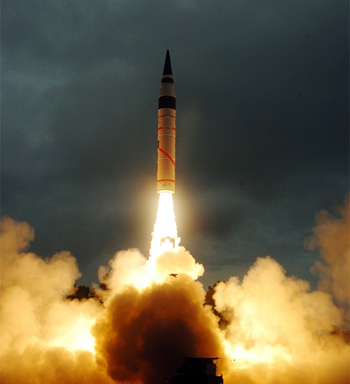INDIAN ARMED FORCES CHIEFS ON
OUR RELENTLESS AND FOCUSED PUBLISHING EFFORTS

SP Guide Publications puts forth a well compiled articulation of issues, pursuits and accomplishments of the Indian Army, over the years

I am confident that SP Guide Publications would continue to inform, inspire and influence.

My compliments to SP Guide Publications for informative and credible reportage on contemporary aerospace issues over the past six decades.
India joins ICBM 5000+ league
 |
By Lt. General P.C. Katoch (Retd) Former Director General of Information Systems, Indian Army |

India successfully undertook the fourth and final test firing of the Agni-V today (December 26) from Wheeler Island, off the coast of Odisha. This is a wholly indigenously developed ICBM, which by itself is a gigantic achievement. Even the BrahMos missile, which is a short range ramjet supersonic cruise missile (not in ICBM category), has been developed with Russian collaboration. With Agni-V, India joins the exclusive club of five countries that already possess intercontinental ballistic missiles (ICBMs) with a range of over 5,000-5,500 km; the five countries being US, Russia, China, France and the UK.
The first test of the three-stage Agni-V was conducted in April 2012 in open configuration, followed by the second test in September 2013 in similar configuration. However, the third test conducted in January 2015 saw the ICBM being fired from a hermetically sealed canister mounted on a Tatra truck launcher truck. This third launch on January 30, 2016, successfully proved operational flexibility for the Armed Forces for swiftly transporting and firing the ICBM from anywhere they want. This was a game changer from earlier firings in open configuration. The missile had vertically blasted off from the truck mounted launcher and splashed down in the India Ocean 20 minutes later. The mobile canister-version ensures the 50-ton missile can be fired from stop-to-launch in just few seconds, as also higher reliability, longer shelf-life and lesser maintenance. The reaction time required to fire Agni-V is small, making it highly survivable and enabling assured retaliatory-strike capability, in line with India’s ‘no first use’ nuclear policy.
DRDO sources had then said that only one more test of Agni-V was required, after which the objective was to begin induction by end of 2015 itself. Understandably, India had decided to delay the final test of Agni-V because of the negotiations for India to join the 48-country Nuclear Suppliers Group (NSG). Unfortunately China, smarting under the fact that India was granted membership of the 34-nation Missile Technology Control Regime (MTCR) while the same was denied to China, decided to block India joining the NSG. China has indicated, it will continue to block India joining NSG - acting global ‘watchdog’ while herself blatantly violating provisions of the NSG through nuclear proliferation. China’s stance that she does not believe in waivers, (NPT in case of NSG membership) is hollow because China herself agreed to a waiver in favour of India during the Indo-US Nuclear Deal of 2008. However, any support from China on any issue, leave aside for NSG would be utopian considering China now is inexorably coupled with Pakistan in an anti-India embrace, even repeatedly protecting terrorist-mullahs of Pakistan at the UN. In today’s test the Agni-V ICBM was tested to its full range. The Agni-V will bring whole of China within range.
The Agni-V has a range of 5,500 to 5,800 km and is nuclear capable with a payload capacity of 1,500 kg of high-explosive warhead. Interestingly, the Chinese media went bellyaching with the Indian plans to deploy BrahMos missiles in our northeast along the Line of Actual Control (LAC) with China. India’s Strategic Forces Command (SFC) already holds the shorter-range Prithvi and Dhanush missiles, and has inducted the Agni-I, Agni-II and Agni-III missiles as well - mainly geared towards Pakistan. The Agni-IV and Agni-V are specifically meant for deterrence against China. Following today’s final test of the Agni-V, the SFC will begin user trials. It will perhaps take another two years for this ICBM to be fielded with the SFC. As per DRDO sources, they are capable of developing ICBMs with strike ranges of 10,000 kms or more comparable to China’s DF-31A missile that can hit targets at 12,200 kms range. However, this is a policy decision that the government may not want to take for the time being considering that the Agni-V will cover whole of China. As of now, the DRDO has also been working upon ‘maneuvering warheads or intelligent re-entry vehicles’ to defeat enemy ballistic missile defence systems as well as multiple independently targetable re-entry vehicles (MIRVs) for the Agni missiles; single missile carrying several nuclear warheads, with each programmed individually to hit different targets. Every Indian was looking forward to today’s launch of Agni-V and India joining the exclusive ICBM 5000+ League. This indeed is a proud moment and feather in the cap of the DRDO.





